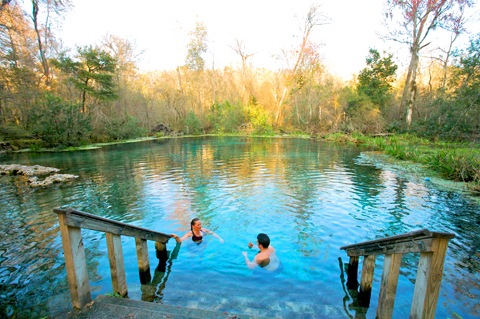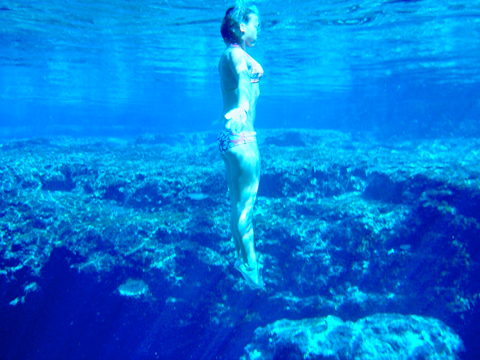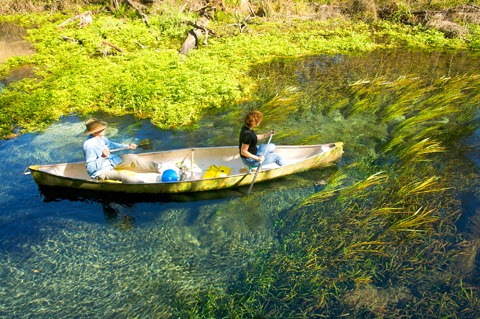It’s a warm late-winter afternoon in northern Florida, and three young women are gingerly descending a half-dozen wooden stairs to a mouthwash-blue pool of translucent water ringed with cypress trees. Yesterday, they paddled the Ichetucknee River, a clear, narrow stream fed almost exclusively by nine major springs. Today, at this popular swimming hole in the town of High Springs, they want full immersion.
After taking a deep breath, Beth Ann Rutledge of Tallahassee swims down into the pool, an earthen cavity called Ginnie Spring that discharges approximately 110 million liters of water per day, feeding the cola-colored Santa Fe River.
As she drops beneath a limestone shelf at the edge of the spring, the opening widens. Passing a couple of fish, she reaches the entry point to the spring’s source, an aquifer that connects to scores of other springs through a network of underwater caves. She touches a toe to the white sandy bottom, and, in a cloud of bubbles, kicks back to the surface. “I did it!” she announces after her head pops up.

PHOTO: NY TIMES NEWS SERVICE
Twenty meters away, a volleyball game is under way. Wet suits and scuba gear are strewn across a picnic table. A short distance farther, wooded campsites are thick with tents. A sign at a restaurant and dive shop depicts a mermaid with long blond hair blown back, not unlike the fluorescent-green aquatic eel grass that crops up beside these northern Florida springs, ever-bent by the continuous outward flow of water.
Visit the natural freshwater springs of northern Florida, and you may find it impossible to resist plunging in, or at least riding along the surface in a kayak or tube. Typically surrounded by trees and lush vegetation, the springs are often an eerily beautiful blue or green. Some are so clear that kayakers photographed on them appear as if they were floating on air.
The purity of the water at Ginnie Spring has attracted the Coca-Cola Co, which has a permit to extract up to 2,271,00 liters a day from a deeply placed well there and bottles some of it as Dasani water. And with water temperatures a cool 20°C to 22°C, these alluring springs are unlikely spots for a nervous Northerner’s meeting up with an alligator, or so their aficionados insist.

PHOTO: NY TIMES NEWS SERVICE
At least 30 billion liters of water a day gush up out of the Floridan aquifer, according to the US Geological Survey, mostly in northern and central Florida, which has one of the largest concentrations of springs in the world. “It is one of the few places where you can actually look down into an aquifer,” said Harley Means, a geologist with the Florida Geological Survey.
The region’s limestone substrate is so permeable, and the water table so close to the surface, that water readily works its way up from the ground. Besides generating rivers, the springs create, in effect, windows and doorways into the aquifer itself.
While long overshadowed by the state’s theme parks and beaches, the springs are well-known locally. Floridians use these waters for swimming, diving, snorkeling, canoeing, kayaking and tubing.

PHOTO: NY TIMES NEWS SERVICE
At Rum Island Springs, a cabin can be rented for the weekend beside a turquoise pool of water twice the size of a large Jacuzzi. Poe Springs, in an 80-hectare Alachua County park, has concrete steps leading into clear blue water. Blue Spring, Naked Spring, Johnson Spring and Kiefer Spring are all accessible from the privately owned Blue Springs swimming area in High Springs. More springs are preserved in more than a dozen state parks, including Troy, Manatee, Ponce de Leon and Wakulla Springs.
Ginnie Spring, where Rutledge was proudly taking her dip, is the anchor of Ginnie Springs Outdoors, described on its Web site as a campground and dive resort.
On a paddle upstream from there on the Santa Fe, along the Santa Fe Canoe Trail, a dozen more springs show themselves before flowing into the sluggish river, which is as wide as a three-lane highway. Its wooded banks are sparsely dotted with docks, lawn chairs and the occasional house. (Along this passage, on the river rather than in the springs themselves, alligator sightings are considered one of the attractions, and swimming is not advised.)
The canoe trip ends at O’Leno State Park, where the Santa Fe emerges from the ground after flowing for 5km underground farther upstream.
Ginnie Spring is in High Springs (population 3,600), a town with a historic district, craftsman homes and antiques shops that has also become the state’s unofficial natural springs capital, a base for weekenders and vacationers. The town has two dive shops, canoe and kayak outfitters and tube rental establishments. The Great Outdoors, a new restaurant, bottles a beer called Naked Ed Ale, named for Ed Watts, who for 20 years has greeted visitors to the lovely but remote Lilly Spring clad in only a necklace, wire-rimmed glasses and a loin cloth. (According to The High Springs Herald, ownership of the land where he had his hut is under dispute. The hut recently burned.)
High Springs is also the headquarters of a film production company specializing in high-definition underwater cinematography. Its owner, Wes Skiles, has shot underwater scenes for Imax, National Geographic and PBS. A loyalist to the Florida springs, he prevailed upon Sony Pictures to hold the premiere of The Cave, a horror film for which he did underwater shots, in High Springs.
“For water, springs are a way out,” Skiles said one day in February while negotiating the Santa Fe in his motorboat. “But they also have a way of drawing people in.”
High Springs lies in a rural pocket of Florida between Jacksonville and Tallahassee where muddy cattle farms are studded with moss-cloaked cypress trees. Residents of this area talk easily of hydrological features like springsheds, swallets (entry points into the aquifer for rainwater) and vents.
“You look at mud puddles around here a little differently,” said Cindy Butler, a nurse who moved to the area from Orlando 10 years ago to be close to the springs. “You start to wonder where they might go.” Many local stories involve sinkholes, which are geologically related to the springs. Janice Richardson, who works the ticket booth at the Priest Theater in High Springs, recalled one time when a tractor was swallowed up, and another, about three years ago, when an entire house went into a sinkhole.
More recently, emphasis has shifted toward conservation. Drive down these rural farm roads and you’ll come upon small blue signs indicating you are coming into a Springs Conservation Area. Planning to tube the Ichetucknee? Get there early. The number of users permitted on the river is limited, and rules spell out what can and cannot be taken along.
“College kids used to float kegs of beer down here,” Bee Gee Wolfe, a canoeist, said at the put-in to the Ichetucknee. “Now it’s much more of an eco-tour.”

On April 26, The Lancet published a letter from two doctors at Taichung-based China Medical University Hospital (CMUH) warning that “Taiwan’s Health Care System is on the Brink of Collapse.” The authors said that “Years of policy inaction and mismanagement of resources have led to the National Health Insurance system operating under unsustainable conditions.” The pushback was immediate. Errors in the paper were quickly identified and publicized, to discredit the authors (the hospital apologized). CNA reported that CMUH said the letter described Taiwan in 2021 as having 62 nurses per 10,000 people, when the correct number was 78 nurses per 10,000

As we live longer, our risk of cognitive impairment is increasing. How can we delay the onset of symptoms? Do we have to give up every indulgence or can small changes make a difference? We asked neurologists for tips on how to keep our brains healthy for life. TAKE CARE OF YOUR HEALTH “All of the sensible things that apply to bodily health apply to brain health,” says Suzanne O’Sullivan, a consultant in neurology at the National Hospital for Neurology and Neurosurgery in London, and the author of The Age of Diagnosis. “When you’re 20, you can get away with absolute

May 5 to May 11 What started out as friction between Taiwanese students at Taichung First High School and a Japanese head cook escalated dramatically over the first two weeks of May 1927. It began on April 30 when the cook’s wife knew that lotus starch used in that night’s dinner had rat feces in it, but failed to inform staff until the meal was already prepared. The students believed that her silence was intentional, and filed a complaint. The school’s Japanese administrators sided with the cook’s family, dismissing the students as troublemakers and clamping down on their freedoms — with

As Donald Trump’s executive order in March led to the shuttering of Voice of America (VOA) — the global broadcaster whose roots date back to the fight against Nazi propaganda — he quickly attracted support from figures not used to aligning themselves with any US administration. Trump had ordered the US Agency for Global Media, the federal agency that funds VOA and other groups promoting independent journalism overseas, to be “eliminated to the maximum extent consistent with applicable law.” The decision suddenly halted programming in 49 languages to more than 425 million people. In Moscow, Margarita Simonyan, the hardline editor-in-chief of the